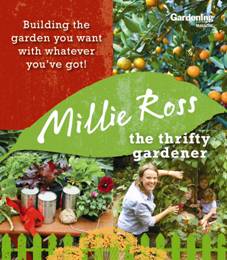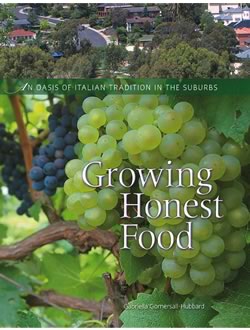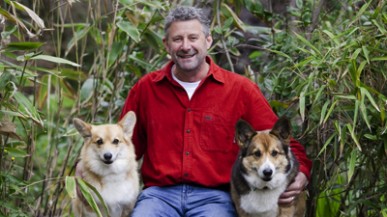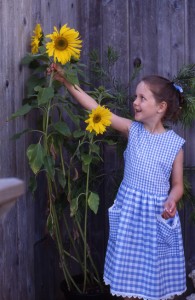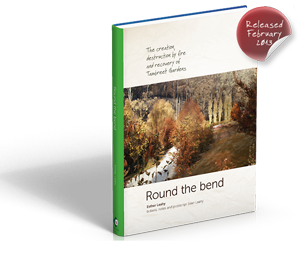 The creation, destruction by fire and recovery of Tambreet Gardens
The creation, destruction by fire and recovery of Tambreet Gardens
Review by Penny Woodward
Probably the most interesting gardening book I have read this year, this is the story of a garden created, lost and then recreated. Esther and Sean Leahy moved to the property, a small farm on six acres in 2003 and over the following six years created a garden and retreat. Then on the 7th of February 2009 in the Black Saturday fires, the garden was destroyed, although they managed to save the house. In beautiful prose, Esther describes the process of watching the garden recover and then recreating the garden. I love the descriptions of trees they thought lost, but with great patience they waited, many started to regrow although it sometimes took two years before they could be sure. Some would regrow but then fall victim to winds or pests. Each one feels like a friend. Many of the Australian plants survived by putting out epicormic growth, or reshooting from the ground. But surprisingly many introduced trees recovered too. Oaks, maples, ginkgoes, liquid ambers and coast redwoods being some, although many took three or more years before they were back to their normal cycles. In the end the survivors were pretty much equally divided between native and non-native. They also watched the insects, spiders, reptiles, birds and mammals slowly returning. Some in plague proportions, but eventually the balance was restored. A steady stream of family and friends aided their own long hours of labour, but now, four years later the garden is nearly completely recovered. Read more
Review by Penny Woodard
Building the garden you want with whatever you’ve got.
Millie’s personality leaps from every page of this engaging and informative book. In the introduction she says “Experiment, play, plant, cut, kill, compost, dig, and, every now and then , push your luck.” “Your efforts (or lack of them!) can help a garden to thrive or just survive, but don’t stress – tomatoes were making tomatoes well before we got involved.” We so often over complicate gardening and Millie is telling us to just get out there and give it a go. With chapters on planning, designing and building gardens, as well as growing, planting, loving and eating your produce, The Thrifty Gardener is full of fascinating tips as well as careful and sound advice. Millie’s emphasis very definitely reflects the title with suggestions about using found and recycled materials right through the book. In the chapter on growing she looks at bottles for garden edges, wooden pallets to make mobile beds and everything from toasters to polystyrene boxes and food tins as pots. The planting chapter covers plants to grow for fibre and structure, plants for hot spots, for privacy, for birds, for frogs, for windbreaks, for play, for ponds and much more.
I thoroughly recommend this book for both the beginner and more experienced gardener, but especially if you are a do-it-yourself person (most true gardeners are) and/or someone who needs to garden on a small budget. The Thrifty Gardener has a real sense of fun as well as being full of wise thoughts.
Borrow it from your local library, buy it from an independent bookshop or go to the ABC shop to purchase a copy online.
By Millie Ross, $35.00, Harper Collins Publishers
(The book was given to me by the publishers)
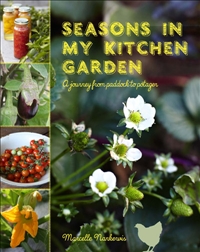 A journey from Paddock to Potager
A journey from Paddock to Potager
Review by Penny Woodward
Some books are practical and useful, some tell a story, some are beautiful to hold and use: Seasons in my Kitchen Garden is all of these and more. The first thing I noticed about Marcelle Nankervis’s delightful third book was the design, which makes the most of the lovely photographs. Delectable close ups of fresh produce, snippets of farm life, and only two photos of Marcelle (I hate this current trend where gardening books and magazines have more photos of the author than they do of the produce or garden!). The book starts with the story of why Marcelle and her family moved to the small farm and this story continues, interwoven between practical seasonal pages about the how to, growing and harvest of fruit and vegetables. She tells of the things that worked, and the things that went terribly wrong. How she wouldn’t put the pigs next to the house again, how her children have become her pest controllers and how they now all wear safety goggles anytime they are working on the farm (you have to read the book to find out why). Read more
Eager to keep their Italian traditions alive after coming to Australia in 1965 Lina and Tony Siciliano started a new life together in suburban Essendon. With only a small garden they yearned to grow their own food so in 1981 acquired a barren block of land in East Keilor where they planted fruit trees and vegetables and raised chickens. Thirty years on and the couple have transformed the site into a profitable business boasting a productive bounty of 400 olive trees, an orchard, vegetable garden and their Rose Creek Estate vineyard.
Taking a month by month approach author Gabriella Gomersall-Hubbard has documented the family’s sustainable way of life from preserving – think big tomato day and sausage making – to producing olive oil and wine. Colour photos throughout capture the essence of the Siciliano’s seasonal activities in the garden and kitchen while traditional recipes reinforce that achievable goal of growing organically, knowing where your food comes from and ensuring low food miles. Try a spicy pasta with potatoes and cavolo nero or the slow cooked capretto with fresh peas.
Review by Penny Woodward
This lovely book is full of delights. For those of us lucky enough to have visited Rose Creek Estate, to have met Tony and Lina, and eaten their food, this book is a wonderful evocation of their lives and lifestyle. Read more
As many of you will now know, Stephen Ryan, horticulturalist, author and broadcaster is no longer the host of Gardening Australia. It is their loss, but unfortunately ours too. Stephen is a friend, so this is not totally unbiased, but I believe that the ABC has been foolish in the way they have squandered his talents. Stephen has a knowledge of horticulture that is second to none. For more than forty years he has worked in the world of plants, winning awards and scholarships, writing books and speaking on the subject all over Australia and overseas. But instead of tapping into this ‘fountain of all knowledge’, they used him to do awkward connects between segments and to spruik a viewer’s suggestion. Such a wasted opportunity. Gardening Australia has, for so many years, worked to showcase gardening for people of all abilities. I have been gardening, and writing about gardening now a long time, and have often learnt something new from watching Gardening Australia. But not so much recently. I sense that in sacking someone as charismatic and knowledgeable as Stephen Ryan, Gardening Australia is heading down the track of the commercial stations, going for popular at the expense of informed. I guess we will know more about the trend when we see who is appointed to the new position. I hope the appointment won’t be all about style, rather than substance.
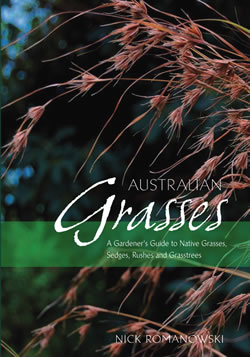 Australian Grasses, A gardener’s guide to native grasses, sedges, rushes and grasstrees.
Australian Grasses, A gardener’s guide to native grasses, sedges, rushes and grasstrees.
Introduced grasses have been popular in our gardens for many years now but not native grasses. To help encourage wider use of Australian grasses we have needed a well-written, accessible book on how to grow and use them, and finally we have one. Nick Romanowski obviously has a passion for, and wide-ranging knowledge of, this subject. In chapter 4 he profiles more than 200 native grasses, sedges, rushes and grasstrees and from the numerous photos we can see that many Australian grasses are as beautiful as the introduced grasses. They also have the added bonus of providing food and shelter to native animals, insects and birds, and unlike introduced grasses, very few of them are weeds or have weedy potential. The early chapters explain the differences between the different forms of grasses, as well as how they can be used in the average garden – lawns, borders, mounds, water gardens, bogs, formal and semi-formal beds and finally in pots. Growing, propagating, maintaining and even eating the grasses is also covered. Read more
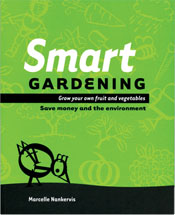 Smart Gardening: Grow Your Own Fruit and Vegetables by Marcelle Nankervis is packed with useful information for the home gardener. Marcelle grew up on a small farm, has a degree in Horticulture and a wealth of experience in gardening. She has worked in the horticultural media for more than 16 years. Part one of Smart Gardening covers all the garden basics from water, sun, soil, fertilising, mulching and pruning, to growing and harvesting fruit trees and vegetables. Part two encompasses the bulk of the book and is a really useful month by month guide divided into tropical, sub-tropical, temperate and cool regions. I would buy it just for the lists of what to sow when because I always forget and plant things too late. My only quibble is the layout. There are no pictures (which is fine) but I find it hard to navigate my way around. Perhaps that will come with time and familiarity. The information is all there though, and this would make a great gift for an organic gardener who is just starting out. To purchase a copy go to any good bookstore or Exisle Publishing
Smart Gardening: Grow Your Own Fruit and Vegetables by Marcelle Nankervis is packed with useful information for the home gardener. Marcelle grew up on a small farm, has a degree in Horticulture and a wealth of experience in gardening. She has worked in the horticultural media for more than 16 years. Part one of Smart Gardening covers all the garden basics from water, sun, soil, fertilising, mulching and pruning, to growing and harvesting fruit trees and vegetables. Part two encompasses the bulk of the book and is a really useful month by month guide divided into tropical, sub-tropical, temperate and cool regions. I would buy it just for the lists of what to sow when because I always forget and plant things too late. My only quibble is the layout. There are no pictures (which is fine) but I find it hard to navigate my way around. Perhaps that will come with time and familiarity. The information is all there though, and this would make a great gift for an organic gardener who is just starting out. To purchase a copy go to any good bookstore or Exisle Publishing
Smart Gardening by Marcelle Nankervis, Exisle Publishing, $34.99
By Ellen
Mum always thought it was only a matter of time before I became I keen gardener. But on the eve of my 22nd birthday I still don’t feel any strong desire to rave about the brilliance of borage or the magnificence of mint. Growing up with my mother Penny Woodward was always a trade off between gardens and ice cream, gardens and play grounds, gardens and mini golf. My brother and I went with her to the gardens, if we behaved ourselves we got ice cream (or a visit to a play ground, or mini golf). This being said, some of the most memorable hours of my childhood were in gardens. Especially Heronswood in Dromana on the Mornington Peninsula, watching the goldfish and proudly identifying the elephant garlic. I came to know this allium quite well over the ten years Mum spent writing her book Garlic and friends. Garden visits took us all over Australia, to find mazes, Avenues of Honour, new gardens and plant-oriented ways to write about our family holidays. Read more
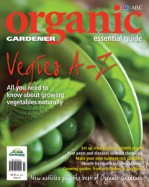 Organic Gardener’s Essential Guide: Vegies A – Z
Organic Gardener’s Essential Guide: Vegies A – Z
Rising costs have combined with anxiety about food security to create a critical moment for people considering growing their own food. Right on cue is “Vegies A-Z”. It’s the third OG special (after Getting Started, $10.00, and Fruit, $10.00). Vegies A-Z combines new material with recent OG articles from reliable writers. My quibble with this third volume is that there is not more on soil preparation, which is crucial. Perhaps that’s in Getting Started? Perhaps the three volumes need to be read seriatum, and would make a great gift, possibly to yourself. PW is a major contributor. — AMS.
Note: There is more on soil preparation in Getting Started which is unfortunately currently out of print. A reprint is planned for later this year
Borrow a copy from your library, buy one from your local newsagent or go to the store on this website and buy a copy online

